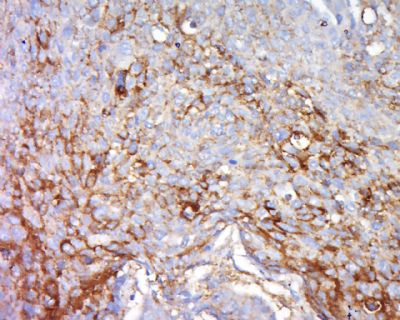产品货号 : mlR11284
英文名称 : FGFBP2
中文名称 : 纤维细胞生长因子结合蛋白2抗体
别 名 : KSP37; FGF-binding protein 2; FGF-BP2; FGFBP-2; FGFBP2; FGFP2_HUMAN; Fibroblast growth factor-binding protein 2; HBp17-related protein; HBp17-RP; Ksp37; 37 kDa killer-specific secretory protein.
研究领域 : 免疫学 信号转导 生长因子和激素
抗体来源 : Rabbit
克隆类型 : Polyclonal
交叉反应 : Human,
产品应用 : ELISA=1:500-1000 IHC-P=1:400-800 IHC-F=1:400-800 ICC=1:100-500 IF=1:100-500 (石蜡切片需做抗原修复)
not yet tested in other applications.
optimal dilutions/concentrations should be determined by the end user.
分 子 量 : 23kDa
细胞定位 : 细胞外基质 分泌型蛋白
性 状 : Lyophilized or Liquid
浓 度 : 1mg/ml
免 疫 原 : KLH conjugated synthetic peptide derived from human FGFBP2/KSP37:121-220/223
亚 型 : IgG
纯化方法 : affinity purified by Protein A
储 存 液 : 0.01M TBS(pH7.4) with 1% BSA, 0.03% Proclin300 and 50% Glycerol.
保存条件 : Store at -20 °C for one year. Avoid repeated freeze/thaw cycles. The lyophilized antibody is stable at room temperature for at least one month and for greater than a year when kept at -20°C. When reconstituted in sterile pH 7.4 0.01M PBS or diluent of antibody the antibody is stable for at least two weeks at 2-4 °C.
PubMed : PubMed
产品介绍 : KSP37 is a 223 amino acid protein that is secreted into the extracellular space and belongs to the fibroblast growth factor-binding protein family. Expressed in serum, as well as in cytotoxic T lymphocytes and peripheral leukocytes, KSP37 is thought to be involved in lymphocyte-mediated immunity, possibly playing a role in the development of asthma. The gene encoding KSP37 maps to human chromosome 4, which encodes nearly 6% of the human genome and has the largest gene deserts (regions of the genome with no protein encoding genes) of all of the human chromosomes. Defects in some of the genes located on chromosome 4 are associated with Huntington's disease, Ellis-van Creveld syndrome, methylmalonic acidemia and polycystic kidney disease.
Subcellular Location:
Secreted. extracellular space.
Tissue Specificity:
Expressed in serum, peripheral leukocytes and cytotoxic T lymphocytes, but not in granulocytes and monocytes (at protein level).
Similarity:
Belongs to the fibroblast growth factor-binding protein family.
SWISS:
Q9BYJ0
Gene ID:
83888
Important Note:
This product as supplied is intended for research use only, not for use in human, therapeutic or diagnostic applications.
产品图片












